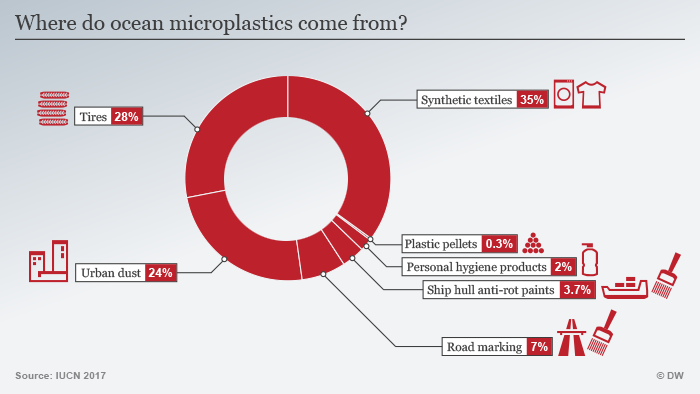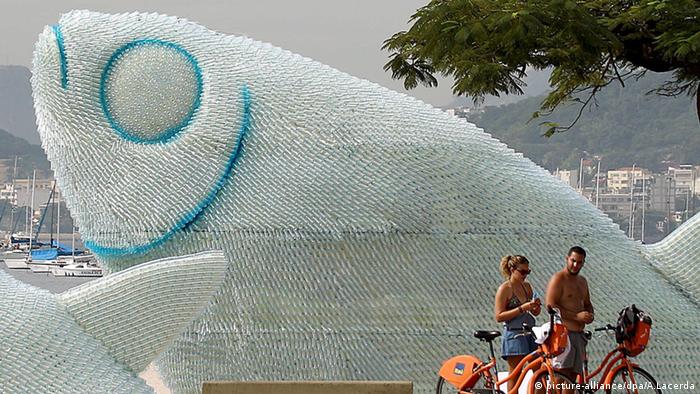Por Ellen Nemitz · ECO - 18 de dezembro de 2024 - Câmara ressuscitou “jabutis” da…
River of plastic trash is flooding our oceans

Plastic is useful – for packaging, tires, clothing, and much else. But 2 percent of plastics produced end up in the ocean. It enters the food chain – even reaching us. A new analysis highlights the scale of the problem.
From a historical perspective, plastics are a very new phenomenon. Total global plastics production in 1950 was just over 2 tonnes (2.2 tons) – that’s less than the weight of a single Dodge Durango sport utility vehicle. In 2015, just 65 years later – that is, over the span of less than a single human lifetime – global production amounted to 448 million tonnes.
We currently use a global average of about 60 kilograms (132 pounds) of plastic per year per person. In the most industrialized regions – North America, western Europe and Japan – that figure is more than 100 kilograms.
In a new study, researchers have estimated that about 8.3 billion tonnes of plastic have been manufactured out of crude oil since 1950. Of that total, about 30 percent remains in use – in households, cars or factories. A further 10 percent has been burned.
That leaves 60 percent of the total amount of plastic produced to date leading a twilight existence as rubbish, either tucked away in garbage dumps or discarded more haphazardly. Globally, this means there’s about 650 kilograms of plastic garbage per person – out there, somewhere.
And that somewhere is often the world’s oceans. The International Union for the Conservation of Nature (IUCN) estimates that 2 percent of total plastics production ends up in ocean waters.
Once there, plastic persists for years, since it’s not biodegradable or digestible. It typically fragments into ever-smaller pieces. Some of that is swallowed by marine organisms, entering into food webs – which is not good for marine ecosystems. Nor is it good for people who eat fish.

“We’re heading toward a plastic planet,” said University of California researcher Roland Geyer, who co-authored the new paper. They are calling for more attention to the problem. He added that the global growth in plastics production is “extraordinary – and it doesn’t look like it’s going to slow down anytime soon.”
Researchers estimate that if present trends continue, by 2050 there will be around 12 billion tonnes of plastic garbage present in the world.
Plastics from textiles, traffic and cosmetics
Microplastics are plastic particles with a size in the micrometer or nanometer range (0.0001 to 0.0000001 of a centimeter).
Abrasion and disintegration of plastic waste into the sea is one source of microplastics. Another is the abrasion of plastics on land. Most microplastics are released by synthetic textiles, as lint. Around 60 percent of clothing contains synthetic fibers – and this proportion is expected to increase, in part because synthetic fibers are cheap to produce.
That makes for a lot of plastic lint worldwide. Studies have shown that from a single fleece jacket in a single wash cycle, up to a million tiny fiber fragments are released into a washing machine’s wastewater.
According to a current EU study, in Europe alone, washing machines rinse some 30,000 tonnes of synthetic fibers into the sewage system each year.
And as they wind their way downstream, some of those fibers end up in the sea.

Paints for road-marking and to prevent ships from rotting also contribute to the entry of microplastics into oceans. Tiny bits of plastic abraded from tires and road markings are transported by wind and water into creeks and rivers. Eventually, some of this ends up in the sea.
More garbage than fish in the oceans?
Unless trends shift, within three more decades, the total mass of plastic junk swimming in the oceans may be greater than the total mass of fish.
Microplastic are too small to be seen with the naked eye. Mussels, marine worms and fish take in some of these tiny fragments as they go about feeding. Since plastics cannot be digested, this accumulates in such organisms – when predators feed on these smaller organisms, they also get the plastics. Like other pollutants, microplastics become more concentrated higher up the food web.
Studies have shown ingestion of microplastics can have adverse effects on various marine animals. These effects include reduced reproductive success, slower growth, and more sluggish movement, as well as greater tendency toward inflammation and increased mortality.
There isn’t enough information available yet to allow researchers to definitively pin down the nature and severity of such effects.

Scientists don’t yet know in detail which chemical toxins are transferred from plastics to the environment, or into the flesh of marine organisms. Research into the environmental and biological impacts of marine microplastics remains in its infancy.
What is known is that some small amount of microplastic is inevitably absorbed by human beingswhen we eat fish or crustaceans.
The United Nations Environment Program (UNEP) has issued a statement saying microplastics are not currently considered a significant risk to human health. Yet at the same time, it acknowledges that little data are available, and that further research is needed.
Problem recognized?
Ocean pollution is now on the international agenda. In early June in New York, the United Nations in its Oceans Conference aimed to encourage member countries to put forward projects and programs for protecting the health of ocean ecosystems.

Environmentalists are sounding the alarm about plastics in our oceans
The G20, or group of the world’s most weighty economies, has similarly put ocean pollution on their agenda with a shared action plan to reduce marine garbage, also agreed in June.
Does that mean the problem is on its way to being solved?
“If our Earth is to stay the blue planet, then we have to stop choking the oceans with garbage,” said German Environment minister Barbara Hendricks. “The dimension of the global flood of garbage has become inconceivably huge. So I’m very glad about the agreement of the G20 on a common action plan. This brings the protection of our oceans a big step forward in global consciousness.”
“We have to take action on a broad international basis.”
x
Environmental groups have welcomed this agreement as a good step. Yet the G20 action plan pays insufficient attention to the causes, some say.
“Governments too often look for answers in recycling, but they should go at the root of the problem: Unnecessary plastic packaging and products shouldn’t be produced in the first place,” according to Thilo Maack, a marine biologist who works for Greenpeace in Germany.
Yet Maack acknowledged that reuse and recycling of plastic products are important too.
In Maack’s view, a key measure to get a grip on the growing flood of plastic garbage would be economic instruments that put environmental costs into the price: “If those costs are priced into plastic products from the beginning, then plastic will be used more sparingly, reused and recycled more.
“And more environmentally friendly alternatives [like biodegradable packaging] would become cheaper in comparison,” Maack told DW.
Fighting the plastic flood

Tons of trash – At least 8 million tons of plastic waste ends up in the world’s oceans every year, according to a report by the Ellen MacArthur Foundation. The report warns plastic trash will outweigh fish by 2050 unless drastic action is taken. Much of the floating trash collects in several large ocean vortices far from land. Beaches, like this one on Midway Island in the remote Pacific Ocean, also suffer.
Addicted to plastic – The floating plastic isn’t just an eyesore: as it breaks down into smaller pieces, marine animals mistake it for food. A recent study by Uppsala University showed ingesting plastic can have devastating effects on fish, including stunted growth and increased mortality rates. Surprisingly, some fish even seem to prefer plastic. Plastic in fish is also suspected of posing health risks for humans.

Edible alternatives – The Ocean Conservancy estimates more than 690 species of marine animals have been affected by plastic pollution. In an effort to reduce the impact of all that waste, some companies have come up with alternatives. The Delray Beach craft brewery, in Florida, has developed edible six-pack rings from wheat and barley left over from the brewing process. It hopes to begin production in October.

Biodegradable packaging – As an alternative to single-use plastic packaging – which makes up a significant portion of the waste found in oceans – some companies have come up with biodegradable alternatives. At a plant in Poland, wheat bran is being used. According to inventor Jerzy Wysocki, the Biotrem packaging can be used in the oven or freezer, and will decompose in 30 days – or can simply be eaten. Extra fiber!

Bamboo to the rescue? – Fast-growing bamboo is also an alternative to plastic – used to make everything from toothbrushes, shower curtains, utensils and even computer parts. Work at the Tonggu Jiangqiao Bamboo & Wood Industry Company, pictured here, started mass production of bamboo keyboards, mice and monitor casings in 2008.

Ocean skimmer – Alternatives may help reduce waste, but millions of tons of plastic still float around the world’s oceans – and will remain for centuries, slowly breaking down. Dutch foundation Ocean Cleanup aims to collect the trash with a 100-kilometer (60-mile) floating dam system that is supposed to trap plastic waste without harming fish and other sea creatures. It aims to install one in the Pacific by 2020.

From trash to fashion – Some of that plastic could be recycled and reused in other forms, becoming flower pots, home insulation or – in the case of Spanish firm Ecoalf – clothing. The Madrid-based clothing line takes plastic waste collected by 200 fishing boats in the Mediterranean, crushes it into flakes, and then creates polyester fibers – which in turn become fashionable jackets, backpacks and other items.

Reduce, recycle … and reuse – Plastic waste can also be reused in its original form. At the United Nations Conference on Sustainable Development Rio +20 in 2012 – 20 years after the first World Oceans Day – giant fish made from plastic bottles were exhibited along the waterfront in Rio de Janeiro.





Este Post tem 0 Comentários